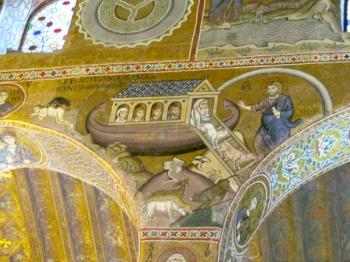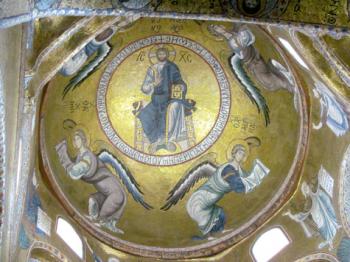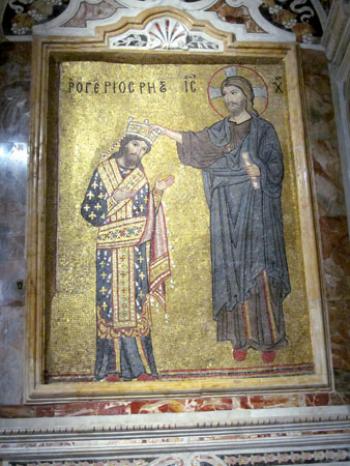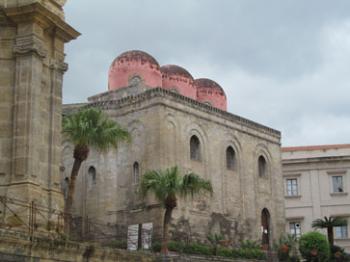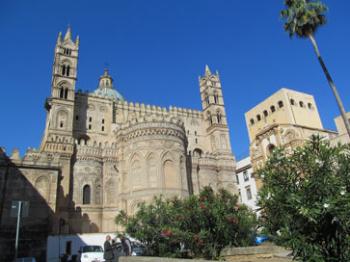Norman Palermo (Part 1 of 2)
This item appears on page 54 of the January 2017 issue.
Norman Palermo
(First of two parts)
Located in the Mediterranean just off the “toe” of the “boot” of Italy, Sicily has been the crossroads for traders, invaders and settlers from other lands for thousands of years.
There were indigenous groups occupying Sicily when the Phoenicians arrived in the eighth century BC. The Phoenicians originally came from the eastern Mediterranean, from the area that is present-day Lebanon, and settled in, among many other places, Carthage in North Africa. One of the colonies they founded, Ziz, was in northwestern Sicily.
The Greeks started colonizing Sicily at about the same time as the Phoenician-Carthaginians. To the Greeks, Phoenician Ziz was known as Panormos. Though the Greeks and the Phoenician-Carthaginians traded with each other, eventually conflict developed between them. Defeat of both came at the hands of the Romans, who made Sicily a Roman province in 227 BC, with Panormos, now called Panormus, becoming the main Roman port.
Vandals and Goths invaded Sicily in the fifth century AD. So did the Byzantines in the following century, remaining to rule for the next 300 years. Then came the Arabs, who dominated the island from the early ninth to the late 11th centuries. Under them, Panormus became Bal’harm, a major center from which the emir ruled.
Arrival of the Normans
Arab rule ended with the arrival of the Normans in 1061. At almost exactly the same time that Normans under William the Conqueror were invading and conquering England (1066), another band of Normans, led by Count Roger, began their conquest of Sicily, a task that took 30 years. Arab Bal’harm became the Norman Palermo.
Norman rule over Sicily lasted barely a century. Under Count Roger and his successors, Palermo blossomed. Churches, palaces and gardens were built.
Norman rule ended in 1194 when Henry VI of Swabia became king of Sicily due to his having married Constance, daughter of Count Roger, several years earlier. Though the days of Norman glory in Sicily were brief, much remains even now after 800 years, making it possible to imagine what Norman life in the 12th century must have been like, at least for the rulers.
It was this splendid Norman past that I set out to discover in the five weeks I spent in Palermo in April-May 2016.
Palazzo dei Normanni
I began at the Palazzo dei Normanni (Norman Palace), built in the 11th century early in the reign of the Norman rulers. The palace is located on a site that was occupied by a fortress constructed by the Phoenician-Carthaginians 1,700 years before the Normans arrived. Massive Punic-era walls can still be seen deep within the palace.
Also on this same site stood the palace of the Arabic emirs, so it is not surprising that the Normans chose to build their own palace here as well.
The highlights of what remains of this Norman Palace are the Joaria, one of the original towers, and the room adjacent to it believed to have been the bedroom of Roger II, son of Count Roger. It’s adorned with marble paneling and mosaics depicting hunting scenes, including leopards and lions, peacocks and swans — a foretaste of the mosaics elsewhere in the palace.
The gem within the Norman Palace is the Cappella Palatina (Palatine Chapel), built by Roger II as his private chapel in the 1130s. It’s an understatement to say that it’s magnificent. The patterned marble floor and the wooden muqarna ceiling (Arabic-style honeycomb decoration) are enough to make this chapel a prime site to visit in Palermo.
Add to these the resplendent mosaics that are some of the most spectacular in the world. There are graphically depicted scenes from the Old Testament. One I love is the angel shoving Adam and Eve out of paradise after they’d eaten the forbidden fruit. There are also scenes from Christ’s life, such as the one of Joseph carrying the child Jesus on his shoulders as Mary rides a white donkey on their flight into Egypt.
However, what dominates and dazzles is the mosaic image of Christ Pantokrator surrounded by angels in Norman-era outfits, filling the cupola at the east end of the chapel. Binoculars and a good description of the mosaics help to fully appreciate the chapel.
The bookstore sells “The Palatine Chapel and the Royal Palace” by Rodo Santoro, which we used for mosaic descriptions.
San Giovanni degli Eremiti
A 10-minute walk from the Norman Palace stands San Giovanni degli Eremiti (St. John of the Hermits), built by Roger II. It’s a complete contrast to the Palatine Chapel. Here there are no glittering mosaics or intricate ceilings.
Approached by a garden overflowing with orange and other citrus trees plus agave and bougainvillea, St. John’s has been stripped of interior decoration and is beautiful in its bare simplicity.
Five squat, rose-colored domes crown the roof, reminding us that a mosque probably preceded the church. All that’s left of the medieval monastery that once stood beside the church are the slender paired columns in the cloister. In its center is a well, possibly from a ninth-century mosque.
In a frenetic city like Palermo that’s full of tourists and traffic, this is one of my favorite spots to get away from it all for an hour.
Archbishop’s church
Also close to the Norman Palace is Palermo’s Duomo (Cathedral), the iconic building that seems to appear on half the postcards sold in Palermo. It’s an eclectic mix of architectural styles. To see what’s left from the Norman era, you need to walk along the outside to the east end to see the three apses, the two towers and the lovely interlacing design unifying it all.
The Cathedral was built in 1184-1185 by an Anglo-Norman archbishop whose name, Walter of the Mill, became Gualtiero Offamilio in Italian. Inside, in monumental tombs, rest some of the main players of the Norman and Swabian eras: Roger II, Henry VI of Swabia, his wife Constance, Frederick II and his wife Constance.
For me, the highlight in the Cathedral is the crypt lined with Roman-era sarcophagi “recycled” centuries later to enclose the remains of medieval notables, including some from the Norman period. The carving on many of their front panels is remarkable and skillfully lit.
Norman gems
The next two places I visited are among my favorites in Palermo. I visited them four times during my Palermo stay. They stand side by side in Piazza Bellini, about a 20-minute walk from the cathedral. Although both were built in the mid-12th century, they could not be more different.
San Cataldo was constructed in 1154 by Maio of Bari, who served as admiral to William I, son of Roger II. With the death of Maio in 1160, the church’s interior was never decorated, except for an inlaid mosaic floor.
San Cataldo is severe and scaled down, an architectural delight with its many angles and arches. On the outside it is as severe and spare as the inside, with crenellated walls and three red bulbous domes crowning its roof, making it resemble a mosque more than a church.
In complete contrast is La Martorana next door. This church was founded in 1143 by George of Antioch, an admiral in the fleet of Roger II. Half a century later, Eloisa Martorana founded a convent. This church became part of the convent, taking the name of its patroness.
The interior is a mix of glorious 12th-century mosaics, particularly Christ Pantokrator surrounded by four archangels in the dome, and 17th-century frescoes. Critics rail at the combination of mosaics and frescoes from two widely separated and stylistically different eras, but I think it’s artistically exciting.
Not to be missed are the two mosaics at the west end of the church, both of which decorated what was once the facade of the church before this end was extended. One depicts George of Antioch at the feet of the Virgin. The other shows Roger II receiving his crown directly from the hands of Christ.
Julie will continue describing her tour of Norman-era Palermo in the next issue.

